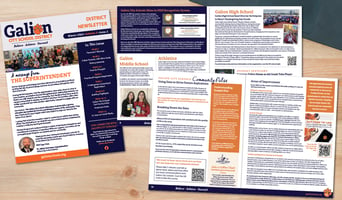Content marketing can never be successful if you don’t have a plan for what you hope to achieve. Is...
Effective Financial Communication for School Districts: Best Practices for Levies - Part 3
As school districts work to effectively communicate their financial strategies and engage their communities, utilizing diverse platforms and creating key materials becomes essential.
This final blog in our three-part series on financial and levy communication will explore additional strategies for enhancing financial communication efforts, focusing on the best platforms for delivering your message and the essential materials needed to inform and engage stakeholders. By leveraging these tools, districts can strengthen community support and ensure a well-informed decision-making process regarding school finances.
Platforms for Your Messaging
Armed with your 3-30-3 messaging and your pass/fail information, you are now ready to build your strategies and deploy your messages.
A key factor in determining your strategies is the Marketing Rule of 7. The Rule of 7 states that on average a customer needs to interact with your brand seven times before a purchase will take place. The same principle can be applied to information from your district - stakeholders need to interact with the content multiple times before reaching an understanding of the topic.
- Social Media: Utilize platforms like Facebook, Twitter, Instagram, and LinkedIn to reach different segments of your audience. Tailor your content to fit each platform's strengths and audience demographics.
- Email Newsletters: Use email to deliver detailed information and updates directly to your school district families. As you would with other important updates, this can be an important tool in reaching those most involved in your district.
- Community Meetings and Town Halls: Host both virtual and in-person events to provide information and a forum for discussion and questions when appropriate. An example of this might be a community meeting regarding the district’s master facilities plan. These events can foster a sense of community involvement and engagement.
- Traditional Media: Leverage local newspapers, radio, and TV stations to reach a broader audience. Press releases with important updates and information can help spread your message widely.
- Your Website: Importantly, your school district's website should serve as the central repository for all of your information, including levy-related details. Ensure it is user-friendly, easy to navigate, and updated regularly with the following information:
- Dedicated Levy Section: Create a specific section on the website for all levy-related content. This should include FAQs, detailed explanations of the levy, financial documents, and impact statements.
- Resource Library: Provide downloadable resources such as brochures, fact sheets, and infographics that community members can share.
- Interactive Features: Incorporate features like calculators to show the impact of the levy on individual taxpayers from the county auditor.
Key Materials for Levy Communications
It’s crucial to develop a range of materials to support your communication efforts. These should be clear, concise, and visually engaging.
Frequently Asked Questions
An FAQ section is essential for addressing common questions and concerns about any levy.
- Comprehensive Answers: Provide detailed, straightforward answers to anticipated questions about the need for the levy, how funds will be used, and the impact on taxes.
- Updates: Regularly update the FAQ to reflect new information and address emerging questions from the community.
Ballot Language Infographic
Ballot language can often be confusing. An infographic can help break it down.
- Visual Clarity & Key Points: Use simple graphics and clear text to explain what a "yes" or "no" vote means. This may include clarifying details in “for” or “against” or simply explaining complicated tax information and costs. Other key points to highlight are what the levy monies will be used for, when the taxes will be collected, and the time period of the levy.
Effective levy communications require a strategic approach that combines clear messaging, stakeholder engagement, and the use of multiple platforms.
By adhering to the strategic communications model and employing best practices, school districts can ensure that their communities are well-informed and engaged in the decision-making process. Transparent, factual, and compelling communication can make a significant difference in the outcome of a levy vote, ultimately benefiting the students and the broader community.
We’re here to help! Let’s work together to make your school district’s communications successful.




